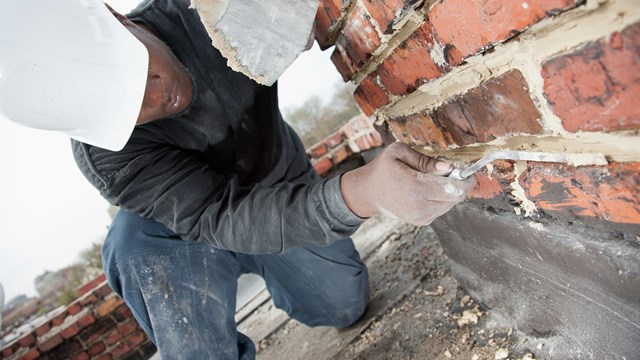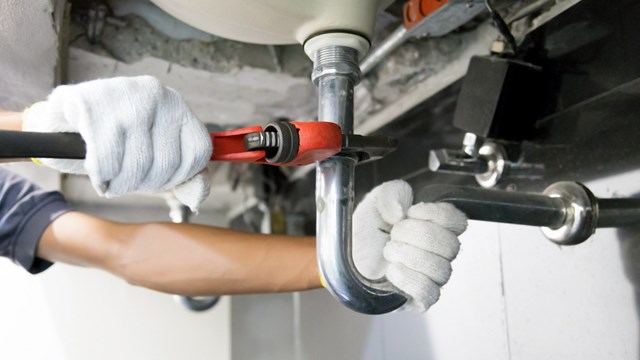The old expression says, ‘put your best face forward,’ and a building façade is more than just the face it shows to the street—it’s a protective barrier against the elements and an integral part of any building’s structure.
But just like your face, a building’s façade needs a regular cleansing. In the 2002 blockbuster movie “My Big Fat Greek Wedding,” the father of the bride, Kostas "Gus" Portokalos, believed that anything could be fixed with Windex. Have a wart? Spray Windex on it. A cut? Spray Windex on it. The narrator even says, “My dad believed in two things: That Greeks should educate non-Greeks about being Greek and every ailment from psoriasis to poison ivy can be cured with Windex.”
So you might think that simply grabbing a scrub brush and a bottle of Windex will clean off months or years of accumulated dirt and grime on a building’s exterior front. Unfortunately, in this scenario, Gus would be disappointed to find out that Windex just isn’t going to cut it. Instead, it’s important to bring in a professional who has the extensive knowledge of building materials, cleaning products and methods to remove dirt, grime and sediment.
Mold/Algae
When it comes to common mold and algae problems on South Florida buildings, the reasoning is simple—it’s all about location, location, location. It’s no secret that South Florida gets a lot of rain and humidity but because many buildings are closer to the ocean, their exteriors need to be cleaned more frequently.
“Without a doubt mold and mildew creates the most dirt and grime on South Florida buildings,” says Kenneth Bolsch, president of Green Earth Power Washing & Recovery in West Palm Beach. “Here in South Florida because of the conditions, the humidity and the temperatures are ripe for growing mold and mildew.”
Jason Evers, president of Coastline Window Cleaning in Fort Myers agrees with Bolsch that mold plays a major role in grimy and mildew-laden South Florida buildings. “Mold and mildew is caused by moisture and limited amounts of sun exposure,” he says. “It’s a humid atmosphere here. The less sun you get, the more moisture builds and if the water is sitting there it will turn to mold and mildew. The longer it goes without sun hitting it, the worse it gets. A lot of residences you’ll notice that where they get the minimum amount of sun exposure is where it’s the dirtiest.”
According to the Florida Department of Health, molds are types of fungi that grow in the natural environment. Mold needs moisture to grow and, in South Florida moisture can come from sources of flooding, any water leaks throughout the building and simply an outdoor sprinkler hitting the building.
Tiny particles of mold are found everywhere in indoor and outdoor air. In nature, mold helps break down dead materials, and can be found growing on soil, foods, plants and other items. Mold is also very common in buildings and homes. Mold produces microscopic cells called "spores" that are spread easily through the air. Spores can also be spread by water and insects. Live spores act like seeds, forming new mold colonies when they find the right conditions.
Tiffany Maron, owner of Squeegee Squad in Tampa with offices in Fort Lauderdale and West Palm Beach, says that mold can also eat through whatever surface that it is on. “Many times customers do not realize what is actually growing on their buildings and the damage it can cause,” she says. “Organisms (mold, mildew, algae) will begin to break down construction materials, creating a more inhabitable environment for higher organisms, which will move in and cause greater damage. If left unchecked, a small ecosystem is created and the waste stream from this ecosystem creates acids that will also break down construction materials—further more deeply penetrating that surface.”
Air Pollution
Mother Nature isn’t the only one to take a toll on buildings. Simply getting into our cars and driving from destination to destination can also affect our homes. “Everything depends on where you are,” says Evers. “If you are along a busy highway, stains and grime on a building would be most likely caused by car exhaust and air pollution.”
Cleaning Up
If management’s method of cleaning the exterior is waiting for a torrential downpour and hoping that it washes away all the dirt and grime—well, that probably just won’t cut it.
“Because of the climate in South Florida, buildings should be cleaned annually,” says Evers. “The majority of homes and residential buildings that we service are on an annual basis. Some do every six months because they don’t like seeing any mold or mildew starting to appear.”
“Building cleaning should be done when mold is first noticed on the walls, soffits or eaves,” says Maron. “Cleaning can be done in stages, but the clean areas may really showcase the areas that have not been cleaned and make the rest of the building look bad. If lift equipment is needed to access the building it is usually more cost effective to do the most at one time that the budget will allow. Lift equipment pricing is more affordable on a daily basis the longer it is used.”
Aside from looking terrible, long term problems can be associated with letting mold, dirt and grime accumulate on buildings.
“Mold can affect your breathing passages,” says Bolsch. “It affects mostly young children and older adults. If you are a strong middle-aged person it could affect you if you had problems with your breathing. That’s why we try to visit and educate people in the health field. Building managers of nursing homes and assisted living residences should have their roofs cleaned more often because it could be a health hazard for their residents. Mold could also become slippery and then it becomes an accident waiting to happen.”
“If you have a shingle roof, the more mildew and mold builds up could create a problem,” says Evers. “If you have a white shingle tile it’s now turning black, which attracts more heat, which over time will break down the roof and it will start to deteriorate. The same thing happens on homes. The more mold and mildew sits on it the more it will deteriorate the paint, and it will ruin your home over a long period of time.”
Exterior Cleaning Products
Exterior cleaning companies aren’t grabbing bottles of Windex, but they are using low-pressure cleaning systems, cleaners and even eco-friendly products. Squeegee’s exterior cleaning procedure utilizes low pressure to apply a biodegradable cleaning product that kills mold and the root of the mold. “This low-pressure method is suitable for brick and stucco exteriors,” says Maron. “However, some staining on brick is actually efflorescence and (a white power that, when visible on the surface of brick, block or stone masonry, is an indication of excessive water within the masonry structure)—exterior cleaning will not remove this stain fully.”
Squeegee Squad also uses a truck-mounted system that uses low pressure to spray the exterior of the building with a biodegradable cleaner to clean up visible mold and a mold inhibitor to kill the origin of the mold. “The low pressure system is suitable for stucco, brick, siding and painted surfaces,” she says. “If a building is primarily glass, then the glass will be cleaned by hand with standard window washing procedures (sponge and squeegee).”
“Years ago it used to be the strongest possible solutions are best, and then those solutions sometimes led to health issues in the people that were applying it,” says Bolsch. “Now the green movement is playing a big part in cleaning supplies. People are appreciating what they have in terms of the Earth and how fragile the Earth is. So it has gone from very caustic substances to environmentally-safer cleaning compounds. A lot of people think that because it’s green it’s very expensive but that’s not the truth anymore, it used to be, but not now.”
When the recession hit a few years ago, building owners were putting off certain cleanings, especially the exterior one. “What they realized is that putting off the cleanings actually ended up costing more money in the long run,” says Maron. “Damage from mold and environmental debris caused discoloration and damage that then had to be repaired instead of just cleaned. The method that Squeegee Squad uses allows us to use minimal chlorine by adding a booster and mold inhibitor. By killing the root of the mold the buildings end up looking better longer than standard high pressure cleaning that just tries to blast off the mold/dirt.”
In between cleanings, building owners can have the maintenance staff make sure that landscaping is trimmed away from the building. Remember to have the exterior cleaned regularly before mold becomes a serious problem. Cleaning costs can vary greatly, depending on the size of your building or number of buildings, the type of work being done and the material being cleaned, among other factors. It’s wise to get several quotes from reputable exterior maintenance companies before hiring a firm to do work on your co-op or condo’s building facades.
Lisa Iannucci is a freelance writer and a frequent contributor to The South Florida Cooperator. Staff writer Christy Smith-Sloman also contributed to this article.







Leave a Comment